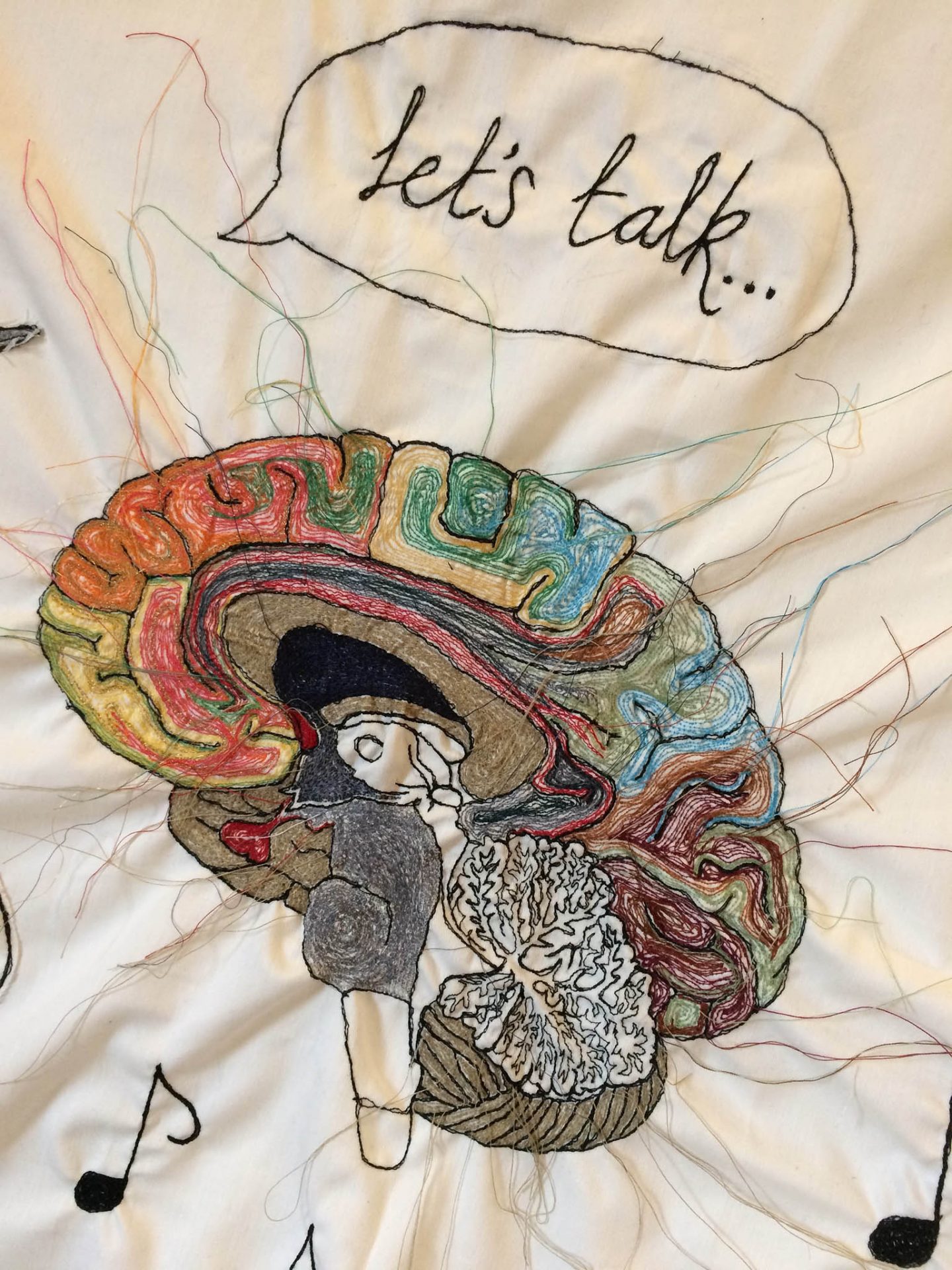Sewing yourself back together
Freehand machine embroidery of a human brain, with a collage of symbolism of various different treatment approaches surrounding it relating to post-natal depression.
Lucy Dundas, Anna Kharas, Fergus McNeile, Leif Moreau, Chloe Parsons, Jai Patel, Annie Rylance, Shruthi Sankaranarayanan, Thompson, Caitlin Xerri
Collaborative Creative Piece, Year One
Exhibited at the Foundations of Medicine Conference, November 2017

I particularly like how the intricacy and detail of this artwork reflects the complexity of postnatal depression. I feel that the various colours used represent how postnatal depression can have an impact on people of all ages and personalities. I also like the exploration of different treatment options in the piece demonstrating that there is always more than one option.
I like how visual and striking this piece of artwork is. I think the different colours and the complexed nature of the pattern nicely represent and convey the complexity of post-natal depression. It shows how when people ask to talk or to help, there is so much going on in their brain and body that it makes it difficult to speak out. I also like how the bright colours give a positive spin on the art piece showing that there is a way out of this dark place.
The embroidery is so detailed and beautiful! I love the use of colours and, to me, the mixing of these threads represents how complex the brain is and how the different parts interlink.
The intricacy of the patterns of thread and the patchwork of colours and texture help to display the complexity of post natal depression and the treatment methods to help with the condition. The unique pattern helps to explore the individuality of the patient and how this differs between patients. The let’s talk caption and music notes demonstrate 2 types of therapy that may have been significant for this person. The colourful, beautiful artwork explores the wonderful complexity of the human brain and the methods needed to “fix” it. The loose threads symbolise the difficulty in treatment and how complicated and “messy” treatment can be. It also made me think about the fact this condition may be externally invisible but incredibly significant for the individual.
I really like the different colours and how they could represent the fact that postnatal depression can have an impact on anyone, of any age
The intricacy of the embroidery could show how complex post-natal depression is.
The music notes could represent a form of therapy for post-natal depression
I think the use of trailing threads is very interesting because to me it indicates this sense of the mind unravelling or falling apart, but could equally be seen as unwinding the complex knot that is PPD. The many colors gives the work intricacy and complexity, much like the illness itself. I really like the speech bubble saying ‘lets talk’ because PPD can be incredibly difficult to open up about, and often mothers feel that they have to carry this burden alone and keep it a secret. So in saying ‘lets talk’ , to me that represents both someone offering a helping hand to a mother with PPD, and also initiating a wider societal discussion that raises awareness about PPD.
Postnatal depression is generally a fairly overlooked topic that has surfaced more in recent years. I like how intricate and elaborate this piece of artwork is as it reflects the complexity of Postnatal depression. Furthermore, the range of colours and lack of pattern within the piece helps reflect how Postnatal depression affects every individual in their own and unique way. Something that really stood out to me about this piece is the music note, as music therapy is a fairly recent method of treatment that can provide a variety of positive impacts, such as helping one to relax or allowing for positive changes in their mood. The other thing that really stood out to me within the art piece was the fact the thread was left loose and not cut. To me, this symbolizes how the treatment for Postnatal depression can vary among individuals as everyone responds differently to different treatments. It also symbolizes how it is not something that can just go away after treatment, but rather is a path to recovery just like how the thread is also a path within the image connecting all the parts of the brain.
Postnatal depression is a complex problem that can make a person feel guilty and alone. I think that this artwork encapsulates this very well ; the confusing pathway of colours and patterns could show that it feels difficult to emerge out of and recover from depression and yet, the loose threads may show that there is a way. The loose thread could also imply the person is unravelling or that the problem can stem beyond the brain and affect other things as well, both in life and the body as mental health is interwoven with our overall biological and social wellbeing. The loose threads could potentially show that despite treatment, there will still be a lasting impression made upon the person (remnants remain). The music notes and “let’s talk” word bubble floating in the periphery could be a treatment that specifically helped a patient or potential things that were offered but never quite connected. The word bubble could be referring to wider society as this could be a shamed topic for discussion, thus urging the public to take action.